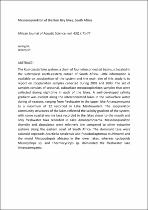JavaScript is disabled for your browser. Some features of this site may not work without it.
- ResearchSpace
- →
- Research Publications/Outputs
- →
- Journal Articles
- →
- View Item
| dc.contributor.author |
Jerling, HL

|
|
| dc.contributor.author |
Weerts, Steven P

|
|
| dc.date.accessioned | 2018-05-31T09:34:42Z | |
| dc.date.available | 2018-05-31T09:34:42Z | |
| dc.date.issued | 2018-03 | |
| dc.identifier.citation | Jerling, H.L. and Weerts, S.P. 2018. Mesozooplankton of the Kosi Bay lakes, South Africa. African Journal of Aquatic Science, vol. 43(1): 71-77 | en_US |
| dc.identifier.issn | 1608-5914 | |
| dc.identifier.issn | 1727-9364 | |
| dc.identifier.uri | http://hdl.handle.net/10204/10244 | |
| dc.description | Copyright: 2018 NISC. Due to copyright restrictions, the attached PDF file only contains the abstract of the full text item. For access to the full text item, please consult the publisher's website. | en_US |
| dc.description.abstract | The Kosi coastal lake system, a chain of four interconnected basins, is located in the subtropical north-eastern corner of South Africa. Little information is available on zooplankton of the system and the main aim of this study is to report on zooplankton samples collected during 2002 and 2003. The set of samples consists of seasonal, subsurface mesozooplankton samples that were collected during nighttime in each of the lakes. A well-developed salinity gradient was evident along the interconnected lakes in the subsurface water during all seasons, ranging from freshwater in the upper lake Amanzamnyama to a maximum of 22 recorded in Lake Makhawulani. The zooplankton community structures of the lakes reflected the salinity gradient of the system, with some coastal marine taxa recorded in the lakes closer to the mouth and only freshwater taxa recorded in Lake Amanzamnyama. Mesozooplankton diversity and abundance were relatively low compared to other estuarine systems along the eastern coast of South Africa. The dominant taxa were calanoid copepods Acartiella natalensis and Pseudodiaptomus stuhlmanni and the mysid Mesopodopsis africana in the lower lakes, whereas cyclopoids Mesocyclops sp. and Thermocyclops sp. dominated the freshwater lake Amanzamnyama. | en_US |
| dc.language.iso | en | en_US |
| dc.publisher | Taylor & Francis | en_US |
| dc.relation.ispartofseries | Worklist;20709 | |
| dc.subject | Coastal lakes | en_US |
| dc.subject | Estuaries | en_US |
| dc.subject | Salinity | en_US |
| dc.subject | Zooplankton | en_US |
| dc.title | Mesozooplankton of the Kosi Bay lakes, South Africa | en_US |
| dc.type | Article | en_US |
| dc.identifier.apacitation | Jerling, H., & Weerts, S. P. (2018). Mesozooplankton of the Kosi Bay lakes, South Africa. http://hdl.handle.net/10204/10244 | en_ZA |
| dc.identifier.chicagocitation | Jerling, HL, and Steven P Weerts "Mesozooplankton of the Kosi Bay lakes, South Africa." (2018) http://hdl.handle.net/10204/10244 | en_ZA |
| dc.identifier.vancouvercitation | Jerling H, Weerts SP. Mesozooplankton of the Kosi Bay lakes, South Africa. 2018; http://hdl.handle.net/10204/10244. | en_ZA |
| dc.identifier.ris | TY - Article AU - Jerling, HL AU - Weerts, Steven P AB - The Kosi coastal lake system, a chain of four interconnected basins, is located in the subtropical north-eastern corner of South Africa. Little information is available on zooplankton of the system and the main aim of this study is to report on zooplankton samples collected during 2002 and 2003. The set of samples consists of seasonal, subsurface mesozooplankton samples that were collected during nighttime in each of the lakes. A well-developed salinity gradient was evident along the interconnected lakes in the subsurface water during all seasons, ranging from freshwater in the upper lake Amanzamnyama to a maximum of 22 recorded in Lake Makhawulani. The zooplankton community structures of the lakes reflected the salinity gradient of the system, with some coastal marine taxa recorded in the lakes closer to the mouth and only freshwater taxa recorded in Lake Amanzamnyama. Mesozooplankton diversity and abundance were relatively low compared to other estuarine systems along the eastern coast of South Africa. The dominant taxa were calanoid copepods Acartiella natalensis and Pseudodiaptomus stuhlmanni and the mysid Mesopodopsis africana in the lower lakes, whereas cyclopoids Mesocyclops sp. and Thermocyclops sp. dominated the freshwater lake Amanzamnyama. DA - 2018-03 DB - ResearchSpace DP - CSIR KW - Coastal lakes KW - Estuaries KW - Salinity KW - Zooplankton LK - https://researchspace.csir.co.za PY - 2018 SM - 1608-5914 SM - 1727-9364 T1 - Mesozooplankton of the Kosi Bay lakes, South Africa TI - Mesozooplankton of the Kosi Bay lakes, South Africa UR - http://hdl.handle.net/10204/10244 ER - | en_ZA |






